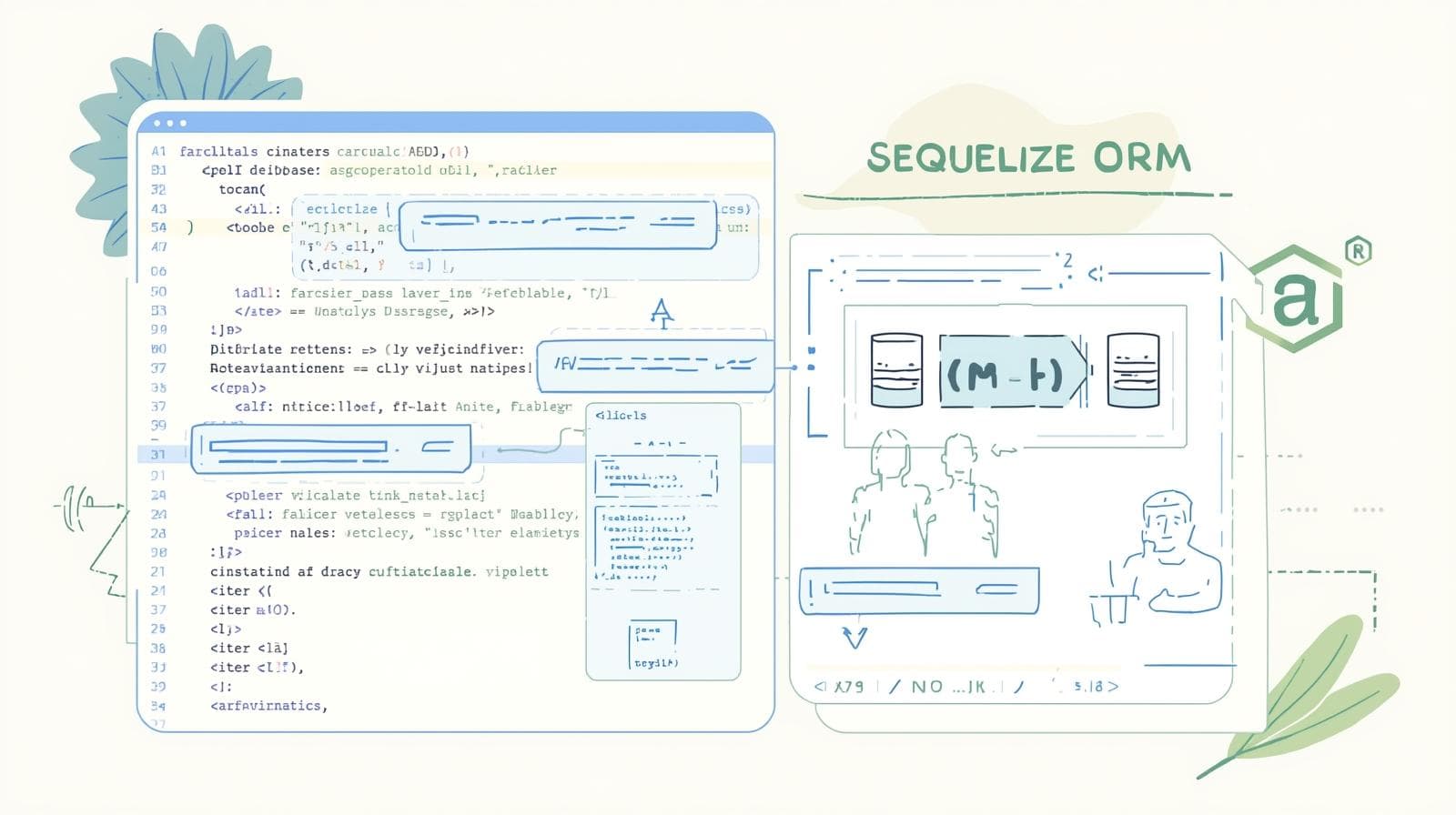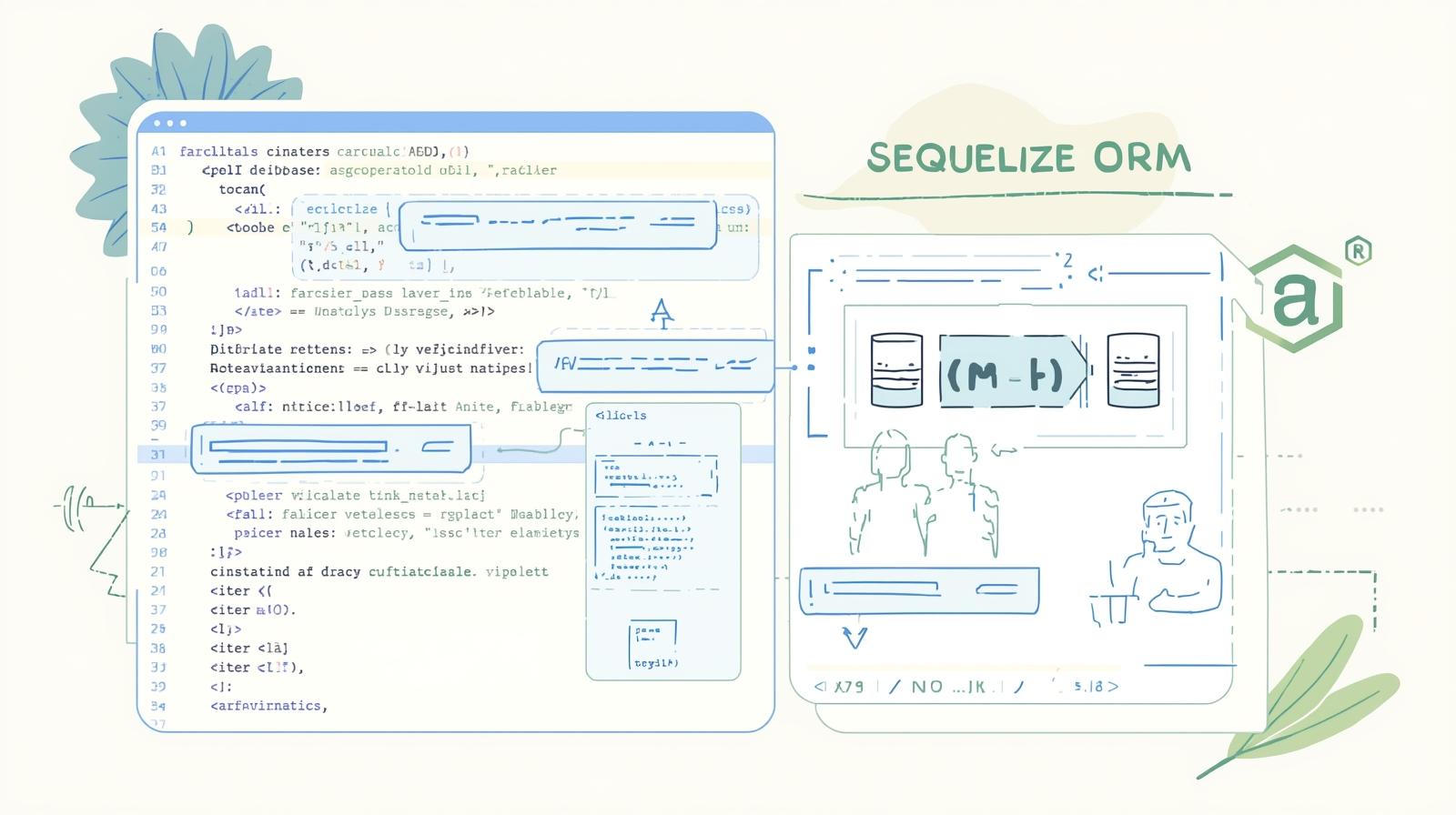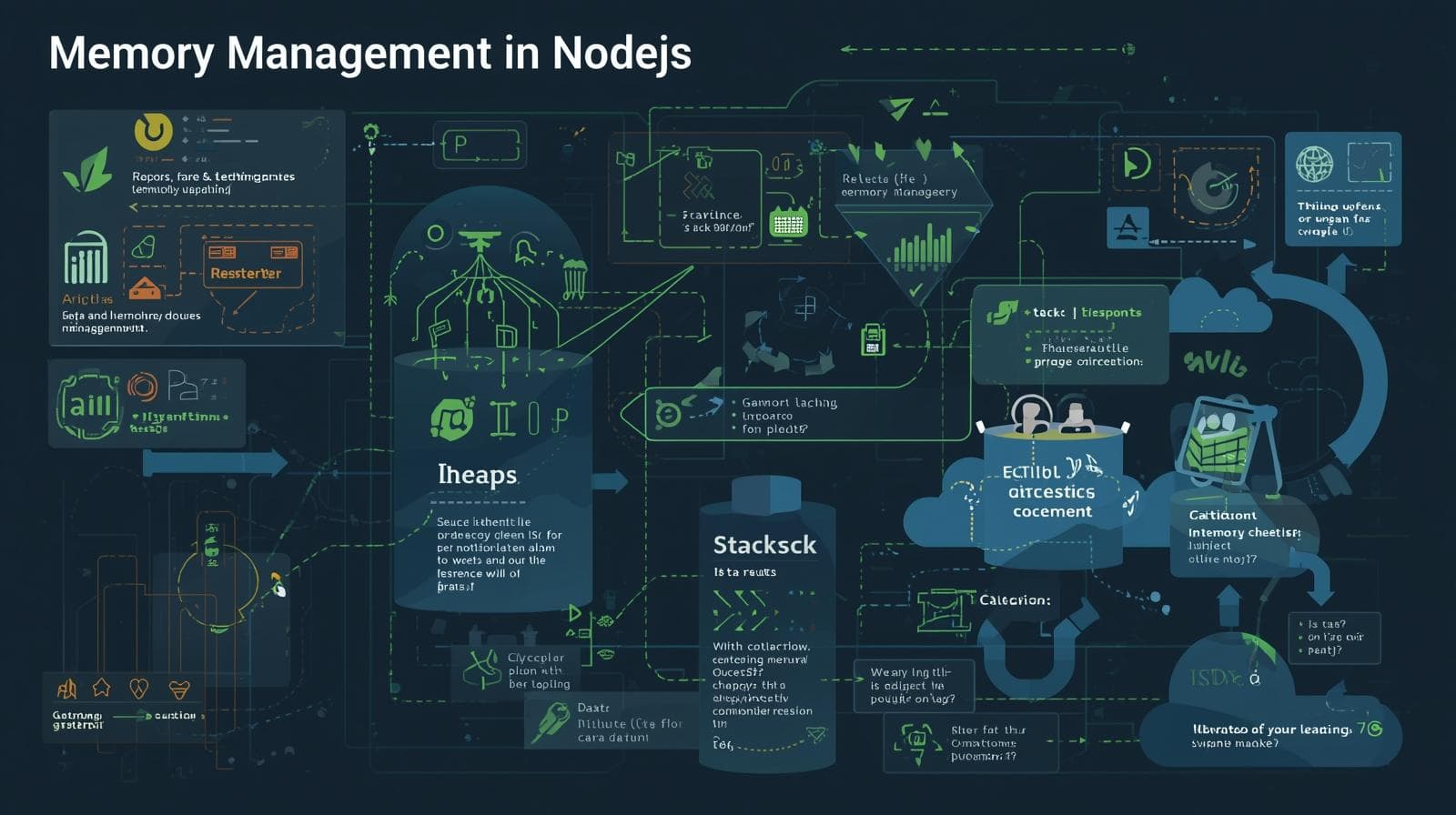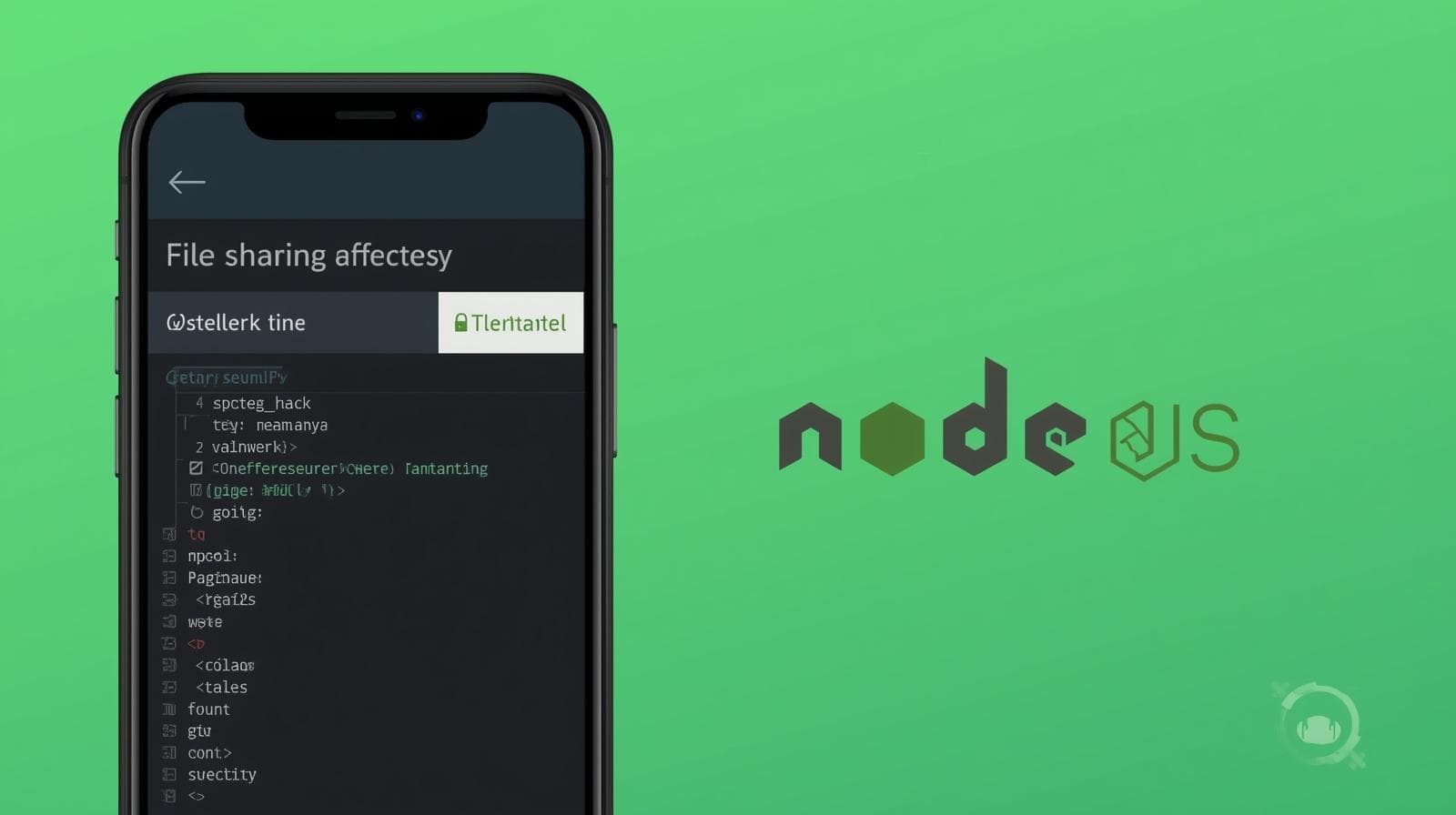Mastering Sequelize ORM: A Complete Guide for Node.js Developers

Dive deep into Sequelize ORM for Node.js. Learn to define models, run queries, handle associations, and follow best practices with real-world examples. Level up your backend skills!

Mastering Sequelize ORM: A Complete Guide for Node.js Developers
Mastering Sequelize ORM: A Complete Guide for Node.js Developers
If you've ever built a Node.js application that needs to store data, you've faced a fundamental choice: how do you talk to your database? You can write raw SQL queries, stringing together SELECT, INSERT, and JOIN statements by hand. It works, but it can get messy, error-prone, and hard to maintain as your application grows.
What if there was a better way? A way to interact with your database using the JavaScript you already know and love?
Enter Sequelize, the hero our Node.js backend development needs.
Sequelize is a powerful, promise-based Object-Relational Mapper (ORM) for Node.js. In this comprehensive guide, we're not just going to scratch the surface. We're going to dive deep. We'll explore what an ORM is, why Sequelize is a top choice, and walk through setting up models, performing CRUD operations, managing complex associations, and much more. By the end, you'll be equipped to use Sequelize confidently in your next project.
Ready to stop fighting with SQL strings and start writing elegant, maintainable database code? Let's begin.
What is an ORM, and Why Should You Care?
Let's start with the basics. ORM stands for Object-Relational Mapper.
Think of it as a translator between two different languages: your programming language (JavaScript) and your database's language (SQL).
Object: This refers to the objects and classes in your code, like a
Useror aProductclass.Relational: This refers to relational database management systems (RDBMS) like PostgreSQL, MySQL, SQLite, and MariaDB, which store data in tables with rows and columns.
Mapper: This is the magic bit that maps (or connects) the objects in your code to the tables in your database.
So, instead of writing this raw SQL:
sql
INSERT INTO users (name, email) VALUES ('Alice', 'alice@example.com');You can write this JavaScript with Sequelize:
javascript
const user = await User.create({ name: 'Alice', email: 'alice@example.com' });See the difference? You're working with objects and methods, not SQL strings. This approach has huge benefits:
Abstraction: You don't need to be a SQL guru to interact with your database effectively.
Security: ORMs automatically handle parameterized queries, which is the primary defense against SQL Injection attacks.
Productivity: Writing
User.create()is much faster and cleaner than writing out a full SQL query string.Maintainability: Your code is more consistent and easier to read and refactor.
Database Agnosticism: Sequelize supports multiple databases. You can switch from SQLite in development to PostgreSQL in production with minimal code changes.
Why Choose Sequelize?
While there are other ORMs and query builders for Node.js (like TypeORM, Prisma, or Knex.js), Sequelize remains a popular and powerful choice because:
Mature and Stable: It's been around for over a decade, with a massive community and a wealth of online resources.
Feature-Rich: It supports everything from simple queries to complex transactions, migrations, and data validation.
Promise-Based: It uses modern async/await patterns, making your code clean and easy to reason about.
Comprehensive Association Support: It handles one-to-one, one-to-many, and many-to-many relationships elegantly.
Setting Up Your Project with Sequelize
Enough theory; let's get our hands dirty. We'll create a simple blog application to demonstrate Sequelize's core concepts.
Prerequisites
Node.js and npm installed on your machine.
A basic understanding of JavaScript and Node.js.
A database system (we'll use SQLite for simplicity, but the concepts apply to others).
Step 1: Initialize the Project
Create a new directory and initialize a Node.js project.
bash
mkdir sequelize-blog-app
cd sequelize-blog-app
npm init -yStep 2: Install Sequelize and the Database Driver
Now, install Sequelize and the CLI tool. We'll also install the driver for SQLite.
bash
npm install sequelize
npm install --save-dev sequelize-cli
npm install sqlite3Step 3: Initialize Sequelize
The Sequelize CLI helps us set up a project structure. Run:
bash
npx sequelize-cli initThis command creates the following folders:
config: Contains aconfig.jsonfile for your database configuration (credentials, dialect).models: Will contain all your model definitions.migrations: Will contain files to version-control your database schema.seeders: Will contain files to populate your database with test data.
Step 4: Configure the Database
Open config/config.json and update it for SQLite. It might look something like this:
json
{
"development": {
"dialect": "sqlite",
"storage": "./database.development.sqlite"
},
"test": {
"dialect": "sqlite",
"storage": ":memory:"
},
"production": {
"dialect": "sqlite",
"storage": "./database.production.sqlite"
}
}For MySQL or PostgreSQL, you would provide username, password, database, host, and dialect instead.
Defining Models: The Heart of Sequelize
Models are the essence of Sequelize. A model is a class that abstracts a table in your database. An instance of a model represents a row in that table.
Let's define two models for our blog: User and Post.
Creating the User Model
We can generate a model and its migration file using the CLI.
bash
npx sequelize-cli model:generate --name User --attributes name:string,email:string,bio:textThis creates two files:
models/user.js: The model definition.migrations/XXXXXXXXXXXXXX-create-user.js: The migration file to create theUserstable.
Let's look at the generated model file (models/user.js):
javascript
'use strict';
const { Model } = require('sequelize');
module.exports = (sequelize, DataTypes) => {
class User extends Model {
static associate(models) {
// define association here
}
}
User.init({
name: DataTypes.STRING,
email: DataTypes.STRING,
bio: DataTypes.TEXT
}, {
sequelize,
modelName: 'User',
});
return User;
};This code defines a User model with name, email, and bio fields. DataTypes define the kind of data each field can hold (e.g., STRING, TEXT, INTEGER, BOOLEAN, DATE).
Creating the Post Model
Now, let's create the Post model.
bash
npx sequelize-cli model:generate --name Post --attributes title:string,content:text,userId:integerOpen models/post.js:
javascript
'use strict';
const { Model } = require('sequelize');
module.exports = (sequelize, DataTypes) => {
class Post extends Model {
static associate(models) {
// define association here
}
}
Post.init({
title: DataTypes.STRING,
content: DataTypes.TEXT,
userId: DataTypes.INTEGER
}, {
sequelize,
modelName: 'Post',
});
return Post;
};Running Migrations
Migrations are like version control for your database schema. They allow you to consistently create and modify tables across different environments (dev, staging, prod).
To create the tables in our database, we run the pending migrations:
bash
npx sequelize-cli db:migrateThis command executes the migration files, creating the Users and Posts tables in your SQLite database.
The Magic of Associations: Connecting Your Models
A blog isn't much without authors. A User can have many Posts, and a Post belongs to one User. This is a classic one-to-many relationship.
We define this in the associate method of our models.
In models/user.js:
javascript
static associate(models) {
// define association here
User.hasMany(models.Post, {
foreignKey: 'userId', // This is the key in the Post model that links back to User
as: 'posts' // This is an alias, useful for eager loading
});
}In models/post.js:
javascript
static associate(models) {
// define association here
Post.belongsTo(models.User, {
foreignKey: 'userId',
as: 'author' // We can call the associated User an 'author'
});
}After defining associations, you need to run your application code that loads all models and calls the associate function. This is typically done in your models/index.js file, which is auto-generated by the CLI and already handles this.
CRUD Operations in Action: Creating, Reading, Updating, Deleting
Now for the fun part! Let's see how we perform basic database operations. We'll create a simple script app.js to demonstrate.
First, let's set up the connection and import our models.
javascript
// app.js
const { Sequelize, DataTypes } = require('sequelize');
const sequelize = new Sequelize('sqlite:./database.development.sqlite'); // Adjust for your config
const models = require('./models'); // This imports all models from the models/index.js file
const { User, Post } = models; // Destructure the models we need
// Test the connection
async function testConnection() {
try {
await sequelize.authenticate();
console.log('Connection has been established successfully.');
} catch (error) {
console.error('Unable to connect to the database:', error);
}
}
testConnection();Create (INSERT)
Let's create a user and a post.
javascript
async function createUserAndPost() {
// Create a user
const newUser = await User.create({
name: 'Jane Doe',
email: 'jane@example.com',
bio: 'A passionate blogger about technology.'
});
console.log('Jane\'s auto-generated ID:', newUser.id);
// Create a post for that user
const newPost = await Post.create({
title: 'My First Blog Post',
content: 'This is the exciting content of my first post!',
userId: newUser.id // Linking the post to the user
});
console.log('New post created with ID:', newPost.id);
}
createUserAndPost();Read (SELECT)
Reading data is where Sequelize shines with its powerful querying capabilities.
Find all users:
javascript
const allUsers = await User.findAll();
console.log("All users:", JSON.stringify(allUsers, null, 2));Find a user by primary key:
javascript
const user = await User.findByPk(1);
console.log("User with ID 1:", JSON.stringify(user, null, 2));Find one user with a specific condition:
javascript
const jane = await User.findOne({ where: { email: 'jane@example.com' } });
console.log("Jane found:", JSON.stringify(jane, null, 2));Find all posts with a specific condition:
javascript
const techPosts = await Post.findAll({
where: {
title: {
[Sequelize.Op.like]: '%Technology%' // Using operators for complex conditions
}
}
});Eager Loading: The Killer Feature
What if you want to get a user and all their posts in a single query? This is called eager loading and it's incredibly efficient.
javascript
const userWithPosts = await User.findByPk(1, {
include: {
model: Post,
as: 'posts' // Use the alias we defined in the association
}
});
console.log("User with their posts:", JSON.stringify(userWithPosts, null, 2));
// This will output the user object, with a 'posts' array containing all their posts.Update (UPDATE)
Updating a record is straightforward.
javascript
// Find the user first
const userToUpdate = await User.findByPk(1);
if (userToUpdate) {
// Update their bio
userToUpdate.bio = 'An experienced software developer and blogger.';
await userToUpdate.save(); // Persist the changes to the database
console.log('User updated successfully!');
}Delete (DELETE)
Similarly, you can delete a record.
javascript
// Find the post first
const postToDelete = await Post.findByPk(5);
if (postToDelete) {
await postToDelete.destroy();
console.log('Post deleted successfully!');
}Real-World Use Case: Building a Robust Data Layer
Imagine you're building an e-commerce platform. Your data model would be complex, with Customers, Products, Orders, and OrderItems. Sequelize would handle this with ease.
Data Validation: You can define validation rules directly in your models (e.g.,
email: { isEmail: true },price: { isFloat: { min: 0 } }).Hooks (Lifecycle Events): You can run functions before or after certain events. For example, hashing a user's password
beforeCreate, or updating a product's stock countafteran order is created.Transactions: For critical operations like processing an order (deducting stock, creating an order record, taking payment), transactions ensure that either all operations succeed or all fail, preventing data inconsistencies.
Scopes: You can define common query fragments. For example, a
activeUsersscope that automatically addswhere: { isActive: true }to your queries.
Mastering these advanced features is what separates hobbyists from professionals. To learn professional software development courses such as Python Programming, Full Stack Development, and MERN Stack, visit and enroll today at codercrafter.in. Our curriculum is designed to give you in-depth, real-world skills just like these.
Best Practices and Common Pitfalls
Use Migrations Religiously: Never manually change your database schema in production. Always create a migration. This keeps your team and your environments in sync.
Validate Data in Models: Don't rely on your front-end to validate data. Define constraints and validations in your Sequelize models—this is your last line of defense for data integrity.
Be Mindful of Eager Loading: While powerful, overusing
includecan lead to complex and slow queries. Use it wisely and only for the data you immediately need.Don't Ignore Transactions: For any operation that involves multiple writes, use transactions. It's a cornerstone of building reliable applications.
Use Environment Variables for Configuration: Never hardcode database passwords. Your
config/config.jsoncan (and should) read from environment variables, especially in production.Learn Raw Queries for Complex Operations: While Sequelize is powerful, sometimes a complex report or a specific optimization is better handled with a raw SQL query. You can use
sequelize.query()for this.
Frequently Asked Questions (FAQs)
Q: Should I use Sequelize with TypeScript?
A: Absolutely! Sequelize has excellent official TypeScript support. You can define static types for your models, which provides better autocompletion and catches errors at compile time.
Q: How does Sequelize compare to Mongoose (for MongoDB)?
A: Mongoose is an ODM (Object Document Mapper) for MongoDB, a NoSQL database. Sequelize is an ORM for SQL databases. They solve similar problems but for entirely different database paradigms.
Q: My queries are slow. What should I do?
A: 1) Use eager loading strategically. 2) Use the logging: console.log option in your Sequelize constructor to see the raw SQL being executed. 3) Use database-specific tools to EXPLAIN the slow query and add indexes accordingly.
Q: Can I use Sequelize with an existing database?
A: Yes! The Sequelize CLI can help you generate models based on your existing tables using the sequelize-auto package.
Q: Is Sequelize still relevant with newer ORMs like Prisma?
A: Yes, it is. While Prisma is a fantastic modern ORM, Sequelize's maturity, feature set, and massive community make it a solid, battle-tested choice for many projects, especially those already using it in production.
Conclusion
Sequelize is a powerful tool that can dramatically improve your productivity and the robustness of your Node.js applications. By abstracting away the raw SQL, it allows you to focus on the logic of your application, writing clean, secure, and maintainable JavaScript.
We've covered a lot of ground—from initial setup and model definition to complex associations, CRUD operations, and best practices. This is just the beginning. The Sequelize documentation is your best friend for diving deeper into its advanced features.
Remember, mastering tools like Sequelize is a key step in your journey to becoming a full-stack developer. If you're looking to solidify your understanding and build complex, real-world projects, consider deepening your knowledge with a structured program. To learn professional software development courses such as Python Programming, Full Stack Development, and MERN Stack, visit and enroll today at codercrafter.in. We're here to help you build the skills for a successful career in tech.









